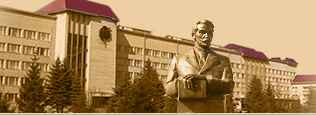SPATIAL STRUCTURE AND CONDITIONS SUSTAINABLE USE OF NATURAL GRASSLANDS IN THE RIVER BASIN ZBRUCH.
The article analyzes the structure of natural forage land basin. Zbruch in the context of grassroots administrative taxa (village councils). The main features of their functional (business) and spatial organization in the study region. Isolation of the major factors of the spatial distribution of landscape particles. The estimation of the impact of land use, depending on their size, technology, and physical and geographical conditions. High potential is concentrated in the upper reaches of the river where the preserved relic of the valley with extensive poorly drained floodplains. There hayfields and pastures perform eco-stabilizing function and are the basis for the development of local environmental network, with limited areas of forests. The high natural productivity of these lands is a factor in the reorientation of agricultural production to increase the share of livestock. A significant decrease in the area observed within Tovtrova ridge, where the main slopes stand phytocenoses tree and shrub, and floodplain areas are severely limited. A small fraction of natural forage is concentrated in high sublatitudinal band plowed Tovtrova south ridge and in the contact zone with the river valley. Dniester. Most of the land under haymaking deteriorated through succession phytocentral composition and subjected to secondary swamping processes due to the destruction of reclamation facilities. Reducing agricultural loading and lack of control over the state of pastures leads to the spread here of tree and shrub vegetation, and as a consequence of the natural reduction in their area. In addition, large areas of arable land is unproductive through the manifestation of waterlogging on the site reclaimed wetlands and a high level of erosion on sloping complexes. Their transfer to the structure of natural forage lands will allow to keep the proportion of agricultural land in the region in the optimization of their use.
Keywords: land use, lands, natural grasslands
References:
- Baranovskyi V.A. Ekolohichna heohrafiia i ekolohichna kartohrafiia. / V.A.Baranovskyi – K.: Fitosotsiotsentr, 2001. – 250 s.
- Kasiianyk I.P. Ekoloho-heohrafichnyi analiz ta otsinka antropohennoi peretvorenosti landshaftiv u mezhakh Natsionalnoho pryrodnoho parku «Podilski Tovtry» / I.P. Kasiianyk // Naukovi zapysky Ternopilskoho natsionalnoho pedahohichnoho universytetu imeni Volodymyra Hnatiuka. Seriia: Heohrafiia. – Ternopil: vyd-vo TNPU, 2007. – #1. – 224 s.
- Kasiianyk L.V., Kasiianyk P.V. Osoblyvosti zemlekorystuvannia u baseini richky Zbruch (na materialakh Khmelnytskoi oblasti) / L.V.Kasiianyk, P.V.Kasiianyk // Naukovi zasady pryrodookhoronnoho menedzhmentu ekosystem Kanionovoho Prydnistrovia: materialy Pershoi mizhnarodnoi naukovo-praktychnoi konferentsii, prysviachenoi storichchiu botanichnykh doslidzhen u rehioni (11-12 veresnia 2014r., m. Zalishchyky). Lviv: Liha-Pres, 2014 – 225s. (S: 193-199).
- Kasiianyk L.V. Vidpovidnist silskohospodarskykh uhid do rehionalnoi landshaftnoi struktury yak kryterii zbalansovanosti pryrodokorystuvannia u baseini richky zbruch (na materialakh Khmelnytskoi oblasti) / L.V.Kasiianyk // Zbirnyk naukovykh prats Podilskoho derzhavnoho ahrarno-tekhnichnoho universytetu. – Kamianets-Podilskyi: Podilskyi derzhavnyi ahrarno-tekhnichnyi universytet, 2015. – 396 s.
- Kasiianyk L.V. Kasiianyk I.P. Struktura silskohospodarskykh uhid, yak kryterii zbalansovanosti pryrodokorystuvannia u baseini richky Zbruch (Na materialakh Khmelnytskoi oblasti) // L.V. Kasiianyk, I.P.Kasiianyk. // Mizhnarodna naukovo-praktychna konferentsiia Heohrafiia, ekolohiia, turyzm: teoriia, metodolohiia, praktyka. Materialy mizhnarodnoi naukovo-praktychnoi konferentsii, prysviachenoi 25-richchiu heohrafichnoho fakultetu Ternopilskoho natsionalnoho pedahohichnoho universytetu imeni Volodymyra Hnatiuka 21-13 travnia 2015 roku. Ternopil: vyd-vo TNPU, 2015. – 224 s.
- Pryroda Khmelnytskoi oblasti / Pid. red. prof. K.I. Herenchuka – Lviv: Vyshcha shkola, 1981 – 128 s.
- Reimers N.F. Pryrodopolzovanye: Slovar-spravochnyk / N.F. Reimers – M.: Mysl, 1990. – 637 s.
- Statystychnyi shchorichnyk Khmelnytskoi oblasti / V.V. Skalskyi. – Holovne upravlinnia statystyky v Khmelnytskii oblasti. Khmelnytskyi, 1992 – 2015.
- Topchyev A.H. Heoekolohyia: heohrafycheskye osnovy pryrodopolzovanyia / Topchyev A.H. – Odessa: Astroprynt, 1996. – 392s.
- Chebolda I.Yu. Vyznachennia ahrarnoho navantazhennia terytorii z metoiu optymizatsii zemlekorystuvannia na prykladi Ternopilskoho administratyvnoho raionu / I.Yu. Chebolda // Naukovi zapysky Ternopilskoho natsionalnoho pedahohichnoho universytetu imeni Volodymyra Hnatiuka. Seriia: heohrafiia. – Ternopil, 2007. – #2. – 224 s.
- Shvebs H.Y. Kontseptsyia pryrodno-khoziaistvennykh system // H.Y.Shvebs – Lymanno-ustevye kompleksy Prychernomoria: heohrafycheskye osnovy khoziaistvennoho osvoenyia. – L.: Nauka, 1988. – S.28–29.
- Kartohrama «Zahalna erodovanist zemel Khmelnytskoi oblasti». Kyiv 1987.
